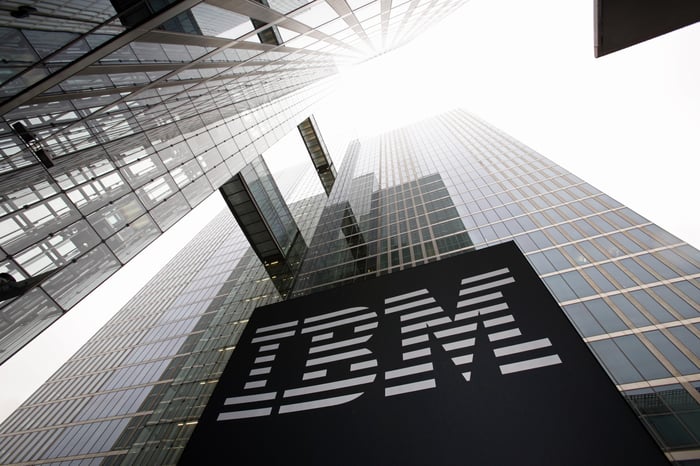International Business Machines (IBM -1.83%) will report its fourth-quarter results after the market closes on Tuesday, Jan. 21. The report will close out a challenging year, with revenue down in 2019 as the company continues to transform itself. The acquisition of Red Hat is part of that transformation, but it won't help IBM's numbers much in the fourth quarter.
What happened last time
IBM's third-quarter report was a mixed bag: Earnings beat analyst expectations, but revenue slumped by more than expected.
|
Metric |
Q3 2019 |
Change (YOY) |
Compared to Average Analyst Estimate |
|---|---|---|---|
|
Revenue |
$18.0 billion |
(3.9%) |
Missed by $190 million |
|
Non-GAAP (adjusted) earnings per share |
$2.68 |
(21.6%) |
Beat by $0.02 |
Data source: IBM.
Adjusted for currency and divestitures, revenue was down just 0.6% in the third quarter.
IBM completed the acquisition of Red Hat last July, so its third quarter numbers did include Red Hat's results. However, IBM was able to recognize only a portion of Red Hat's standalone revenue because of accounting rules related to deferred revenue. While Red Hat would have generated nearly $1 billion of revenue as an independent company, IBM was able to recognize just $371 million of revenue.
While Red Hat's revenue contribution was only partial, IBM did have to recognize all of Red Hat's expenses. That's one reason for the steep decline in earnings.
Like its overall results, IBM's segment results were a mixed bag:
|
Segment |
Revenue |
Change (YOY), Constant Currency |
|---|---|---|
|
Cloud and cognitive software |
$5.3 billion |
8% |
|
Global business services |
$4.1 billion |
2% |
|
Global technology services |
$6.7 billion |
(4%) |
|
Systems |
$1.5 billion |
(14%) |
Data source: IBM.
What analysts are expecting
IBM is expected to report small declines in revenue and adjusted earnings per share in the fourth quarter:
|
Metric |
Average Analyst Estimate |
Change (YOY) |
|---|---|---|
|
Revenue |
$21.63 billion |
(0.6%) |
|
Non-GAAP earnings per share |
$4.69 |
(3.7%) |
Data source: Yahoo! Finance.
Once again, IBM will be required to include all of Red Hat's expenses but only a portion of its revenue. Revenue will get a boost from the z15 mainframe, which began shipping at the very end of the third quarter. The tech giant typically enjoys four to five quarters of strong year-over-year growth in mainframe revenue after each major refresh.
Red Hat can drive growth in the long run
IBM should be able to muster some revenue growth in 2020, thanks to Red Hat and the new mainframe. On a stand-alone basis, Red Hat grew its revenue by 20% in the third quarter. With an annual revenue run rate of roughly $4 billion, that's around $800 million of annual growth if IBM can maintain that rate.

Image source: IBM.
IBM can accelerate Red Hat's growth by selling its software to existing customers with little or no Red Hat exposure. IBM sees a $1 billion annual revenue opportunity for every 5% of its large client base that adopts Red Hat.
The benefit of acquiring Red Hat was on display when IBM announced a 10-year, $1.1 billion deal to overhaul Spanish bank Banco Sabadell's IT systems. Banco Sabadell is moving to a hybrid cloud environment, and Red Hat's OpenShift platform is a key ingredient.
IBM's results will continue to be muddled by revenue recognition rules related to Red Hat in the fourth quarter and into 2020. Earnings will be under pressure this year, but IBM expects EPS to begin to benefit from Red Hat in 2021. Also in 2021, Red Hat is expected to add around $1 billion to IBM's free cash flow.
IBM made a big bet on the hybrid cloud when it paid $34 billion for Red Hat. We'll see over the next few years whether that gamble pays off.





